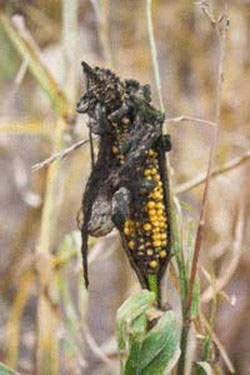Severe thunderstorms and hail are nothing new to Kansas farmers. The threat level is high during this time of year, and parts of Kansas have already seen some destructive hail events in late June and early July (Figure 1). Usually, after every storm, the first question is, how will this affect my crops?

Figure 1. Cornfield with hail damage from a severe storm in early July 2024 near Ingalls, KS. Photo courtesy of Alex Millershaski.
The first question you need to answer is:
How far along in development is your corn?
- At very early stages of the crop, there might not be enough of the plant above ground to sustain any damage.
- If the corn has less than five leaves before the hail, the growing point is likely still below ground. This is good because young corn has a great capacity to recover from early-season hail damage. The growing point of a corn plant is the top of the stem, which contains the cells that are actively dividing and elongating and will become the tassel. Even if the hail took the leaves off and pounded that little plant into the ground, it should grow out of it with few long-term problems.
- The current situation - If the growing point was out of the ground, there could be major damage. Wait a few days, then go back out to look for these signs:
- If the main stem starts to grow again and new leaves come out of the main stem, then there is little damage.
- If you start to see tillers, you may be in trouble. Tillers on corn are vegetative or reproductive shoots that grow from the axillary buds on the lower stalk nodes of a corn plant. These tillers will start growing outward from the base of the damaged plant, and even though they look okay now, they will not be productive during tasseling and ear-forming. This plant should not be counted for stand count when evaluating whether to replant.
So, let’s say you were hit by a hail storm last night, and you go out today to look at your crop. The best thing you can do is get back in the pick-up truck and drive away (unless the crop is completely damaged!). Don’t make any decisions right away; time is your friend. Wait a few days and then come back to check the signs of growth. Even the little plants need a few days to grow so that you can get a stand count of the field.
An accurate estimate of plant survival should be done in the coming days to more precisely determine damaged plants that will survive vs. missing plants – causing stand reductions. Young corn has a great capacity to recover from early-season hail damage. Scout your fields and check for the final number of plants and potential problems associated with these weather events, such as lowered disease resistance (Figure 2).

Figure 2. Corn plants damaged by hail such as this one could be at a greater threat for disease. Photo provided by Kansas Corn.
For more information on hail damage on crop fields, check out the University of Nebraska’s Hail Know website at https://cropwatch.unl.edu/hailknow.
Ignacio Ciampitti, Farming Systems
ciampitti@ksu.edu
Jeanne Falk Jones, Multi-County Agronomist
jfalkjones@ksu.edu
Logan Simon, Southwest Area Agronomist – Garden City
lsimon@ksu.edu
Dale Fjell, former Kansas Corn Director of Research and Sustainability
Tags: weather corn hail severe weather crop injury